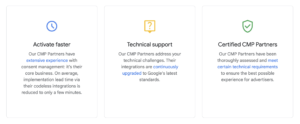As privacy regulations tighten globally, marketers must adapt to stay compliant. From the EU’s Digital Markets Act (DMA) to proposed laws like the American Privacy Rights Act (APRA), businesses are facing new challenges in data collection and usage.
At Saya Agency, we understand the importance of staying ahead of these changes. In this blog, we’ll explore Google Consent Mode V2, its implications for marketers, and how you can update your strategy to remain compliant while maximizing data-driven insights.
Google Consent Mode V2 is an updated feature within Google Tag Manager (GTM) designed to help businesses comply with evolving privacy regulations. It integrates with Consent Management Platforms (CMPs) to manage user consent for data collection and advertising.
At Saya Agency, we recommend implementing Consent Mode V2 to safeguard your marketing strategy while respecting user privacy.
Consent Mode V2 introduces two new parameters:
Actionable Tip: Work with your legal team to ensure these signals align with your compliance requirements.
Consent Mode V2 offers two implementation options:
Actionable Tip: Evaluate the pros and cons of each mode to determine the best fit for your business.
A CMP is essential for managing user consent and integrating with Consent Mode V2.
Actionable Tip: Ensure your CMP is configured to pass consent signals accurately to GTM.
If you operate in the European Economic Area (EEA), updating to Consent Mode V2 is mandatory.
Actionable Tip: Test your implementation thoroughly to ensure compliance and functionality.
Beyond Consent Mode V2, here are additional steps to future-proof your data strategy:

At Saya Agency, we specialize in helping businesses navigate the complexities of data privacy and compliance. From implementing Consent Mode V2 to developing privacy-first strategies, we provide the tools and expertise to keep your marketing efforts effective and compliant.
Ready to future-proof your data strategy? Contact Saya Agency today to learn how we can help you adapt to the evolving privacy landscape.
Ready to take the next step in marketing?
hello@saya-agency.com
+1 310-733 0406
5455 Wilshire Blvd,
Suite 1111
Los Angeles, CA 90036
© 2024 Saya Agency
Ready to take the next step in marketing?